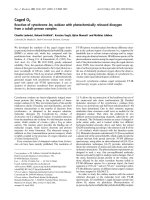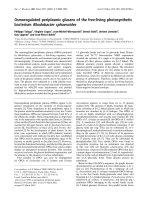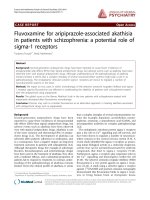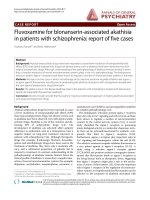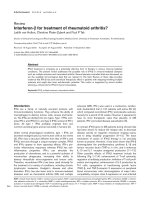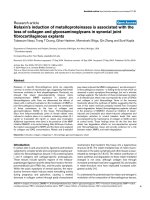Báo cáo y học: " Prospects for control of emerging infectious diseases with plasmid DNA vaccines" doc
Bạn đang xem bản rút gọn của tài liệu. Xem và tải ngay bản đầy đủ của tài liệu tại đây (409.01 KB, 9 trang )
BioMed Central
Page 1 of 9
(page number not for citation purposes)
Journal of Immune Based Therapies
and Vaccines
Open Access
Review
Prospects for control of emerging infectious diseases with plasmid
DNA vaccines
Ronald B Moss
1,2
Address:
1
Vical Inc. San Diego, CA, USA and
2
NexBio, Inc, San Diego CA, USA
Email: Ronald B Moss -
Abstract
Experiments almost 20 years ago demonstrated that injections of a sequence of DNA encoding part
of a pathogen could stimulate immunity. It was soon realized that "DNA vaccination" had numerous
potential advantages over conventional vaccine approaches including inherent safety and a more
rapid production time. These and other attributes make DNA vaccines ideal for development
against emerging pathogens. Recent advances in optimizing various aspects of DNA vaccination
have accelerated this approach from concept to reality in contemporary human trials. Although not
yet licensed for human use, several DNA vaccines have now been approved for animal health
indications. The rapid manufacturing capabilities of DNA vaccines may be particularly important for
emerging infectious diseases including the current novel H1N1 Influenza A pandemic, where pre-
existing immunity is limited. Because of recent advances in DNA vaccination, this approach has the
potential to be a powerful new weapon in protecting against emerging and potentially pandemic
human pathogens.
Throughout recorded history, infectious diseases have
plagued human existence. One effective approach to lim-
iting these diseases has been vaccination. For example, in
a recent report by Roush and colleagues at the U.S. Cent-
ers for Disease Control and Prevention (CDC), ever since
the introduction of vaccines the incidence of infectious
diseases like diphtheria, mumps, pertussis, tetanus, hepa-
titis A and B, Haemophilus influenza and varicella zoster
has declined by more than 80% in the U.S [1]. Further-
more, after the introduction of vaccines, large scale trans-
mission of measles, rubella, and polio has been
eliminated in the U.S., while smallpox has been eradi-
cated worldwide. However, new emerging infectious
pathogens such as HIV (human immunodeficiency virus),
SARS coronavirus (severe acute respiratory syndrome
virus), and highly pathogenic avian influenza (H5N1)
viruses have adapted strategies to rapidly change their
genetic compositions. As the influenza pandemic of 1918
(H1N1) killed approximately 20 to 50 million people
worldwide, massive disease and death is similarly feared
from newly emerging pathogens. In addition, the current
novel swine derived H1N1 pandemic further exemplifies
the need for a rapid and effective vaccine against emerging
pathogens [2]. Thus a vaccination strategy to control
emerging diseases will require a more effective and rapid
response than available from conventional approaches
such as live-attenuated vaccines, inactivated vaccines, or
protein subunit vaccines. Plasmid DNA vaccines, as
reviewed in this article, may be an option to effectively
combat current emerging infectious diseases.
History of DNA Vaccines
Almost 20 years ago, Malone and Felgner at Vical Incorpo-
rated, and Wolff and colleagues at the University of Wis-
Published: 7 September 2009
Journal of Immune Based Therapies and Vaccines 2009, 7:3 doi:10.1186/1476-8518-7-3
Received: 17 August 2009
Accepted: 7 September 2009
This article is available from: />© 2009 Moss; licensee BioMed Central Ltd.
This is an Open Access article distributed under the terms of the Creative Commons Attribution License ( />),
which permits unrestricted use, distribution, and reproduction in any medium, provided the original work is properly cited.
Journal of Immune Based Therapies and Vaccines 2009, 7:3 />Page 2 of 9
(page number not for citation purposes)
consin, demonstrated that mRNA and closed loops of
double-stranded DNA (plasmids) injected into muscle tis-
sue could be taken up by cells at the administration site
(transfection) resulting in the production (expression) of
proteins not normally made by the host cell [3]. It was
soon realized that this approach could be utilized for both
gene therapy as well as vaccine applications, and thus the
field of DNA vaccines was born.
Shortly after these original observations, many groups
including those led by Liu and colleagues at Merck
Research Laboratories [4], Weiner and colleagues at Uni-
versity of Pennsylvania [5], Johnston and colleagues at
University of Texas [6], Robinson and colleagues at Uni-
versity of Massachusetts [7], and Hoffman and colleagues
at Naval Medical Research Center [8], demonstrated that
immunization with DNA could result in the production
of foreign proteins or antigens that stimulate the immune
system resulting in protection from or amelioration of
infectious diseases in animal models. Development in
this area has greatly advanced over the years and human
clinical trials of DNA vaccines have now been conducted
against various infectious pathogens including the
malaria parasite, dengue viruses, cytomegalovirus (CMV),
Ebola virus, seasonal influenza viruses, avian or pandemic
influenza viruses, West Nile virus (WMV), SARS coronavi-
rus, hepatitis B virus, and HIV.
Sidebar 1: Mechanism of plasmid DNA vaccines
The precise mechanism of the induction of immunity
after pDNA vaccination is complex [9] and multi-factorial
(Figure 1).
It is thought that after immunization, transfected muscle
cells may produce antigen or foreign proteins that then
directly stimulate B cells of the immune system, which in
turn produce antibodies. Transfected muscle cells could
possibly transfer the antigen to so-called antigen present-
ing cells (as demonstrated by cross priming) which then
transport the proteins via distinct pathways (the MHC I
for CD8+T cells or MHC II for CD4+T cells) that result in
the display of different processed fragments of expressed
proteins (antigens). Finally, direct transfection of antigen
presenting cells (such as dendritic cells) with subsequent
processing and display of MHC-antigen complexes may
also occur. Because the process of antigen production by
host cells after DNA vaccination mimics the production of
antigens during a natural infection, the resulting immune
Proposed mechanism of DNA vaccinesFigure 1
Proposed mechanism of DNA vaccines.
Journal of Immune Based Therapies and Vaccines 2009, 7:3 />Page 3 of 9
(page number not for citation purposes)
response is thought to be similar to the type induced by
pathogens. Indeed, DNA vaccination generates antigens
in their native form and with similar structure and func-
tion to antigens generated after natural infection.
Sidebar 2: Full Circle - Plasmid DNA Design
A plasmid used in DNA vaccination (Figure 2) contains a
gene encoding an antigen of the target pathogen (immu-
nogen gene). Expression of the protein antigen is "turned
on" in the host cell by a promoter, and "turned off" by a
terminator (a polyadenylation signal sequence, generally
referred to aspoly-A). Other genes such as the bacterial ori-
gin of replication sequence and an antibiotic resistance
gene are incorporated for manufacturing purposes. The
resulting plasmid is a stable, self-contained unit that can
be manufactured by consistent and scalable bacterial fer-
mentation and purification processes.
Sidebar 3: Manufacturing DNA Vaccines
Production of DNA vaccines starts with E. coli cells which
are transformed with the plasmid of interest. These cells
are grown and stored frozen in a stock of vials called a
Master Cell Bank. Growth of the E. coli is typically done
via a fermentation process similar to that used in the man-
ufacturing of certain alcoholic beverages. The recovery
process then requires lysis of the cells, in order to release
the plasmid retained within the E. coli cells. DNA is then
purified using various chromatographic methods.
Advantages
DNA vaccination has many advantages compared with
conventional vaccine approaches (Appendix 1) particu-
larly in the setting of protecting against potentially lethal
emerging infectious diseases. Protecting against a particu-
lar pathogen may require immunity to more than one
component of the organism and may require stimulation
of different components of the host immune system. Tra-
ditionally, most preventive vaccines have relied on anti-
bodies as the main correlate of protection, components
that prevent infection or disease. However, T cells play an
important role in controlling disease for established infec-
tion. Conventional vaccines based on whole pathogens
typically induce immune responses against a number of
irrelevant components of the organism. Subunit protein
vaccines target individual components of the pathogen
and usually only stimulate antibodies. DNA vaccines can
accommodate a combination of different genes that code
for different antigens from one or more different patho-
gens. This can result in the generation of broad immunity
to multiple protein antigens. DNA vaccines have also
been observed to stimulate both antibody and T cell arms
of the immune system including those that are specialized
to kill viruses or cancer cells (via cytotoxic or killer T cells).
A significant advantage, especially for emerging patho-
gens, is that DNA vaccines do not require the handling of
potentially deadly infectious agents. In addition they have
a significantly shorter production time, something para-
mounrt with an ongoing pandemic.
Safety
Overall, a well-tolerated safety profile has been observed
in human clinical trials of DNA vaccination [10]. Early in
the development, there were numerous theoretical safety
concerns regarding DNA vaccines. In particular, there
were concerns about the fate of the injected genes and the
potential for insertion into the host DNA possibly result-
Components of DNA VaccinesFigure 2
Components of DNA Vaccines.
Promoter
Immunogen
Gene
Antibiotic
Resistance
Gene
POLY A
PLASMID
Replication
Start
Site
Journal of Immune Based Therapies and Vaccines 2009, 7:3 />Page 4 of 9
(page number not for citation purposes)
ing in the uncontrolled stimulation of other genes such as
those that may cause cancer. These concerns have dissi-
pated over the years based on thousands of human sub-
jects who have undergone DNA vaccination or plasmid-
based gene therapy. Furthermore, in pre-clinical safety
studies in animals, the potential for plasmid integration
into the host genome has been shown to be negligible and
several orders of magnitude below the spontaneous muta-
tion rate that occurs naturally in mammalian genes [11].
There were also early concerns regarding the induction of
autoimmune reactions, as DNA may be considered as a
self antigen to the host. Increased rates of autoimmunity
or anti-DNA antibodies such as those observed in Sys-
temic Lupus Erythematosis have not been observed in
clinical trials of DNA vaccination [12]. Interestingly, as
plasmid DNA vaccines are noninfectious, significant
immune responses are not developed against the plasmid
itself. Therefore only specific immune responses to the
expressed antigen are stimulated with this approach. In
contrast, with viral vectors such as adenoviruses, pre-exist-
ing and post vaccination immunity to the vector itself can
be generated thereby limiting the pathogen specific
immune response In contrast, DNA vaccination can be
repeated without diminishing the specific immune
response. This may be a pertinent beneficial aspect of
DNA immunization, particularly in light of recent clinical
trials in humans using viral vector-based vaccines, such as
the common cold adenovirus, where immunity to the vec-
tor itself has been raised as a potential safety issue [13,14].
In summary, the potential risks of DNA vaccines appear to
be minimal based on safety data from human clinical tri-
als in thousands of subjects.
Recent Advances in Optimizing Immune Responses to
DNA Vaccines
Over the years, much progress has been made in optimiz-
ing DNA vaccine immunogenicity. Recent progress has
targeted many different aspects of DNA vaccination which
has successfully resulted in improved immune responses
(Appendix 2).
Plasmid Optimization
With regard to the plasmid itself, significant advances
have been made in optimizing the genetic sequence of the
encoding gene as well as other related components. Co-
administration of the plasmid that encodes the pathogen
along with other genes that encode for immune stimulat-
ing substances such as cytokines or chemokines has also
been used to further enhance the immune response of cer-
tain DNA vaccines [15].
In some cases, once various components of the plasmid
have been optimized, the encoded protein may be suffi-
ciently immunogenic without the need for additional
components (unformulated or "naked" DNA) such as
adjuvants. One of the earliest trials in humans of an
unformulated or "naked" DNA vaccine was one that tar-
geted the malaria parasite. Wang and colleagues at the
Naval Medical Research Institute immunized 20 subjects
with a plasmid that encoded naturally occurring forms of
malaria proteins [16]. In this trial, more than half of the
subjects were shown to have cells that can kill or lyse
malaria infected cells (cytotoxic T cell or killer cells). In a
more recent clinical trial, a DNA vaccine optimized for
human expression and encoding modified forms of West
Nile Virus proteins was studied by Martin and colleagues
at the National Institute of Health (NIH) and demon-
strated that the vaccine stimulated antibodies that inhib-
ited the virus (neutralizing antibodies) in all individuals
receiving the vaccination regimen [17]. This unformu-
lated DNA vaccine appears to induce a similar level of
immune responses to those observed in vaccinated horses
protected from WNV. In addition, a recent clinical trial by
these same NIH researchers tested an optimized but
unformulated DNA vaccine for SARS coronavirus and
demonstrated neutralizing antibodies in all subjects who
received three doses of the vaccine [18].
Route of Delivery
Another area of research to enhance the immune response
to DNA vaccines is related to the route of administration.
Although intramuscular injection is the predominant
route of vaccine delivery, other routes of administration
have also been studied such as intradermal delivery. It is
conceivable that intradermal delivery, which is a more
superficial injection, may result in better transfection of
antigen presenting cells, particularly a type of cell called
dendritic cells.
Mode of Delivery
The mode of delivery may also be a pertinent factor in elic-
iting the proper immune response after DNA immuniza-
tion.
Needle and syringe is the predominant method to deliver
both DNA vaccines as well as conventional vaccines.
However, Roy and colleagues at PowderMed (now Pfizer
Incorporated) have used DNA precipitated onto gold par-
ticles which are driven into to skin with a blast of pressu-
rized gas, and called this approach "particle-mediated
epidermal delivery" (PMED). In one clinical study by Roy
and collaborators using PMED, individuals exhibited
potent antibody responses to a hepatitis B DNA vaccine
[19]. In another study, Drape and colleagues at Pow-
derMed also observed strong antibody responses to the
influenza virus DNA vaccine with the PMED approach
[20].
Another approach for the delivery of DNA vaccines is the
use of needle-free devices. Needle-free injection of DNA
Journal of Immune Based Therapies and Vaccines 2009, 7:3 />Page 5 of 9
(page number not for citation purposes)
vaccines has been utilized in numerous clinical studies
and appears to be well-tolerated and may have some
advantages of further augmenting the immune response
to DNA vaccination. For example, Nabel and colleagues at
the NIH injected individuals intramuscularly with a six-
plasmid unformulated DNA vaccine for HIV (Env A, Env
B, Env C, subtype B gag, Pol, and Nef) with the needle-free
device (Biojector
®
2000) and observed HIV specific T-cell
immune responses in over 75% of individuals[21]. Simi-
larly, this same group at the NIH completed a recent study
of an Ebola DNA vaccine also using this same needle-free
device. They demonstrated that Ebola-specific antibody
and CD4+ T-cell immune responses were elicited in all
individuals who received the three-dose vaccination regi-
men [22].
Another novel mode of enhancing DNA vaccines has been
a more invasive technique called electroporation. This
method involves administration of brief electrical pulses
of various voltages, after injection of a DNA vaccine, in
order to enhance the uptake of DNA, presumably through
the formation of transient pores in the muscle cell mem-
brane. Many groups have shown encouraging results
using electroporation in animals. One of the first groups
to use this technique, Ulmer and colleagues, at Chiron
Corporation, demonstrated that antibody and T-cell
responses to the HIV protein Gag encoded in a DNA vac-
cine were enhanced by electroporation in rhesus
macaques [23]. More recently, studies by Pavlakis and col-
leagues at the NIH have also noted that DNA potency
measured by T-cell responses to the HIV protein Gag was
augmented in nonhuman primates using electroporation
[24]. Although encouraging in the strong magnitude of
responses generated in animals, the wide clinical applica-
bility of electroporation in humans in relation to tolera-
bility remains to be determined.
Some researchers have used plasmid DNA in what has
been called a heterologous "prime-boost" vaccination
approach. This method involves delivery of one or more
plasmid DNA vaccine priming doses followed by a boost
with a viral vector (such as adenovirus) which codes for
the same antigens. In the prime-boost setting, DNA vacci-
nation plays an important role in priming different types
of T-cells (CD4+ and CD8+ T-cells) specific for various
proteins. In studies, for example, by Nabel and colleagues
at the NIH, DNA vaccination with plasmids encoding HIV
antigens followed by a boost with an adenoviral vector
carrying the same HIV gene sequences, resulted in
stronger T-cell responses compared with adenoviral vector
or DNA vaccine alone [25]. Similarly, Pantaleo and col-
leagues at the University of Lausanne have shown that a
DNA vaccine for HIV followed by a boost with a poxvirus
vector (NYVAC) resulted in stronger immune responses
compared to immunization with pox vector alone [26]. In
another prime-boost study, Jacobson and colleagues, at
the University of California at San Francisco, immunized
subjects with a DNA vaccine for CMV who were then
boosted with a live-attenuated CMV virus (Towne strain).
Faster and stronger virus-specific T-cell responses were
observed in the group of subjects that received the DNA
and Towne strain compared with a group of subjects that
received the Towne strain alone [27].
Formulated DNA Vaccines
An area of potentially paramount importance for DNA
vaccines is formulations and adjuvants. Adjuvants are
common to most licensed vaccines and are included to
potentiate the immune responses elicited by vaccination.
For DNA vaccines, various delivery systems and adjuvants
have been tested. One of the earliest promising adjuvants
for plasmid DNA vaccines was poly-lactide coglycolide
(PLG), cationic microparticles. Ulmer and colleagues at
Chiron Corporation evaluated HIV DNA vaccines formu-
lated with PLG microparticles and found strong antibody
and T-cell responses in macaques [28]. Poloxamers repre-
sent another class of adjuvants tested with DNA vaccines.
Some poloxamers are nonionic block copolymers, and
when combined with a cationic surfactant, bond with
DNA to form small particles. A study by Wloch and col-
leagues at Vical Incorporated examined DNA immuniza-
tions of human volunteers with cytomegalovirus (CMV)
plasmids formulated with a specific poloxamer adjuvant.
In that study CMV-specific T-cell responses were detected
in a majority of CMV sero-negative individuals who were
vaccinated [29].
Vaxfectin
®
is another example of a delivery system and
adjuvant for DNA vaccines that has been recently tested in
humans. Vaxfectin
®
is a cationic lipid- based adjuvant that
bears a positive charge that binds electrostatically to neg-
atively charged DNA. Studies in animals also demon-
strated that Vaxfectin
®
-adjuvanted DNA vaccines can be
protective against lethal viral challenges. For example,
Webby and colleagues at St. Jude Children's Research
Hospital and Vical Incorporated, immunized ferrets with
three plasmids containing DNA components of the H5N1
pandemic influenza virus formulated with Vaxfectin
®
[30].
After one or two immunizations, all animals were com-
pletely protected from lethal pandemic influenza virus
challenge, while unvaccinated control animals died. Sim-
ilarly, Griffin and colleagues at Johns Hopkins immu-
nized juvenile and infant rhesus macaques by
intramuscular and intradermal routes with measles anti-
gen encoding plasmids formulated with Vaxfectin
®
[31].
All of the vaccinated monkeys developed strong and dura-
ble neutralizing antibodies and they were challenged with
high doses of measles virus after one year. All of the
unvaccinated control animals developed viremia and
became ill with rashes in contrast to the vaccinated ani-
Journal of Immune Based Therapies and Vaccines 2009, 7:3 />Page 6 of 9
(page number not for citation purposes)
mals which remained healthy and had no detectable virus
levels. Lastly, the first human clinical trial of a DNA vac-
cine formulated with Vaxfectin
®
has been completed with
plasmids that encode pandemic influenza virus antigens
(H5N1). The preliminary results reported from this trial
by Smith and colleagues at Vical Incorporated suggest that
vaccination with H5 DNA plasmids formulated with this
adjuvant were well-tolerated and stimulated strong H5
antibody responses in up to 67% of subjects [32]. Nota-
bly, the antibody response rate and safety profile observed
in this trial are comparable to most conventional protein-
based vaccines for pandemic influenza.
Approved DNA Vaccines
Although DNA vaccines have yet to be approved for
human use, three have already been approved for animal
health.
As noted in Appendix 3, the first DNA vaccine approved
for animal health was one that protected horses against
WNV. WNV is a mosquito-borne virus, which causes
encephalitis or inflammation in the brain of infected ani-
mals and humans. Prior to approval of a vaccine, approx-
imately one-third of the horses infected with WNV would
die or be euthanized. The WNV DNA vaccine, developed
by Fort Dodge Laboratories, was approved by the U.S
Department of Agriculture (USDA) in 2005 after the dem-
onstration of safety and efficacy[33].
A DNA vaccine has also been recently approved to prevent
a fatal viral disease that afflicts salmon, called infectious
hematopoietic necrosis virus. In mid-2001, an epidemic
occurred in Atlantic salmon killing up to 90% of the fish.
Scientists at Aqua Health, a unit of Novartis in Canada,
conducted a field trial by immunizing millions of sal-
mons with a single dose of DNA vaccine encoding for a
protein of the virus [34]. The vaccine was approved in
2005 based on the results of this trial that demonstrated
that the vaccine, called Apex-IHN, protected the fish from
death without adverse effects.
Additionally, a therapeutic DNA vaccine designed to treat
dogs with skin cancer (melanoma) was granted condi-
tional approval in 2007. This vaccine was developed
through a collaboration of Memorial Sloan-Kettering
Cancer Center (MSKCC) and Merial Ltd. Canine
melanoma is an aggressive form of cancer. Dogs with
melanomas that have gone beyond initial stages typically
have a lifespan of one to five months with conventional
therapies. In addition, the cancer is often resistant to
chemotherapy. In a study of the DNA vaccine conducted
by MSKCC, many dogs who received the vaccinations
lived beyond the average 13 month survival [35]. Based
on the significantly extended survival, the USDA gave this
DNA vaccine conditional approval in 2007. This is the
first therapeutic vaccine approved by the U.S. government
for the treatment of cancer in animals or humans.
Vaccine Production Time for Emerging Infectious Diseases
Perhaps most relevant to emerging infectious diseases,
DNA vaccines have the distinct advantage of a rapid devel-
opment time, are non- infectious, and have a well-defined
manufacturing process. DNA vaccines contain no infec-
tious components and can be produced safely without the
handling of hazardous infectious agents. Furthermore,
there is a well-defined analytical process for the manufac-
turing of all DNA vaccines, which is universally applicable
to any DNA vaccine.
Vaccination is an important component of a response to
potential pandemics such as avian influenza. According to
the World Health Organization (WHO), since November
2003, approximately 400 cases of human infection with
highly pathogenic avian influenza A (H5N1) have been
reported worldwide [36]. Pandemic (H5N1) influenza
virus has evolved into at least 10 distinct clades or subc-
lades. As noted earlier, the emergence of triple-reassort-
ment swine influenza with limited cross reactivity
antibody responses after vaccination with seasonal influ-
enza vaccines suggests the need to rapidly produce new
vaccines to this particular emerging virus [37]. The manu-
facturing time of conventional protein-based vaccines
may be excessive, as they typically require growth in egg or
cell cultures, which involve a relatively slow production
time. DNA vaccines, in contrast, have estimated vaccine
production times that can be months earlier, as only the
DNA sequence is required and the manufacturing process
is standard (Figure 3) [38]. DNA vaccines therefore have a
unique advantage of large scale production for human use
in a relatively streamlined period of time. In the case of
potentially fatal emerging pathogens, reducing the pro-
duction time of an effective vaccine may be critical in pre-
venting spread of infection and death.
In summary, based on recent advances in enhancing pro-
tective immune responses and a well-tolerated safety pro-
file in humans, plasmid DNA vaccines have the potential
to become an integral part of the arsenal dedicated to
enhancing human health by preventing diseases through
immunization in our ever changing microbial environ-
ment.
Competing interests
The author declares that they have no competing interests.
Appendix 1: Potential advantages of DNA
vaccines for emerging pathogens
Ability to immunize against multiple antigens and/or
pathogens
Journal of Immune Based Therapies and Vaccines 2009, 7:3 />Page 7 of 9
(page number not for citation purposes)
Ability to stimulate both T-cell and antibody immunity
Safety profile
Nonviral and no induction of anti-vector immunity
Ability to repeat injections (IM or ID)
Strong priming effect
Large rapid GMP manufacturing capabilities
No need to handle infectious pathogens during produc-
tion process
Appendix 2: Optimizing immune responses
elicited by DNA vaccination
• DNA sequence or promoter
• Route
ؠ IM
ؠ ID
• Mode of delivery
ؠ Needle/syringe
ؠ Particle-mediated epidermal delivery
ؠ Needle-free
ؠ Electroporation
• Adjuvant
ؠ Cationic microparticles (e.g., PLGA)
ؠ Nonionic block copolymers (e.g., poloxamer)
ؠ Cationic lipid systems (e.g., Vaxfectin
®
)
• Prime-boost
Appendix 3: Approved or conditionally DNA
vaccines for animal health
Infectious Disease Vaccines
• Infectious hematopoietic necrosis virus in salmon
(Novartis Animal Health)
• West Nile virus for horses (Fort Dodge Animal
Health)
Manufacturing timelines for DNA vaccines compared to egg-based protein vaccinesFigure 3
Manufacturing timelines for DNA vaccines compared to egg-based protein vaccines. F/F = fill finish.
Ͳ
Journal of Immune Based Therapies and Vaccines 2009, 7:3 />Page 8 of 9
(page number not for citation purposes)
Cancer Vaccine
• Melanoma for dogs - conditional approval (Merial
LTD)
Acknowledgements
The author would like to thank my colleagues at Vical Incorporated includ-
ing Vijay Samant, Alain Rolland, Alan Engbring, Jenny Chaplin, and Larry
Smith for their helpful critical comments.
References
1. Roush SW, Murphy TV, Vaccine-Preventable Disease Table Working
Group: Historical comparisons of morbidity and mortality for
vaccine-preventable diseases in the United States. JAMA
2007, 298(18):2155-63.
2. Belshe RB: Implications of the Emergence of a Novel H1 Influ-
enza Virus. N Engl J Med 2009, 18;360(25):2667-8.
3. Wolff JA, Malone RW, Williams P, Chong W, Acsadi G, Jani A, Felgner
PL: Direct gene transfer into mouse muscle in vivo. Science
1990, 247(4949 Pt 1):1465-8.
4. Ulmer JB, Donnelly JJ, Parker SE, Rhodes GH, FeIgner PL, Dwarki VJ,
Gromkowski SH, Deck RR, DeWitt CM, Friedman A, et al.: Heter-
ologous protection against influenza by injection of DNA
encoding a viral protein. Science 1993, 259(5102):1745-9.
5. Wang B, Ugen KE, Srikantan V, Agadjanyan MG, Dang K, Refaeli Y,
Sato AI, Boyer J, Williams WV, Weiner DB: Gene inoculation gen-
erates immune responses against humanimmunodeficiency
virus type 1. Proc Natl Acad Sci USA 1993, 90(9):4156-60.
6. Tang DC, DeVit M, Johnston SA: Genetic immunization is a sim-
ple method for eliciting an immune response. Nature 1992,
356(6365):152-4.
7. Robinson HL, Hunt LA, Webster RG: Protection against a lethal
influenza virus challenge by immunization with a haemag-
glutinin-expressing plasmid DNA. Vaccine 1993, 11(9):957-60.
8. Martin T, Parker SE, Hedstrom R, Le T, Hoffman SL, Norman J,
Hobart P, Lew D: Plasmid DNA malaria vaccine: the potential
for genomic integration after intramuscular injection. Hum
Gene Ther 1999, 10(5):759-68.
9. Shedlock DJ, Weiner DB: DNA vaccination: antigen presenta-
tion and the induction of immunity. J Leukoc BioI 2000,
68(6):793-806.
10. Schalk JA, Mooi FR, Berbers GAM, van Aerts L, Ovelgonne H, Kim-
man T: Preclinical and Clinical Safety Studies on DNa vac-
cines. Huamn Vaccines 2006, 2(2):45-53.
11. Glenting J, Wessels S: Ensuring safety of DNA vaccines. Microb
Cell Fact 2005, 4:26.
12. Liu MA, Wahren B, Karlsson Hedestam GB: DNA vaccines: recent
developments and future possibilities. Hum Gene Ther 2006,
17(11):1051-61.
13. Lu S: Human versus HIV: round 2 defeat in AIDS vaccine
development. Expert RevVaccines 2008:151-3.
14. Schoenly KA, Weiner DB: Human immunodeficiency virus type
1 vaccine development:recent advances in the cytotoxic T-
Iymphocyte platform "spotty business". J Virol 2008,
82(7):3166-80. Epub 2007 Nov 7
15. Kutzler M, Weiner D: DNA vaccines: ready for prime time?
Nature Reviews Genetics 2008, 9:776-788.
16. Wang R, Doolan D, Le TP, Hedstrom RC, Coonaan KM, Charpenvit
Y, Jones TR, Hobart P, Margalith M, Ng J, Weiss Wr, Sedegah M,
Taisne CD, Norman JA, Hoffman : Induction of antigen -specific
cytotoxic T lymphocytes in humans by a malaria DNA vac-
cine. Science 1998, 282:476-480.
17. Martin JE, Pierson TC, Hubka S, Rucker S, Gordon 11, Enama ME,
Andrews CA, Xu Q, Davis BS, Nason M, Fay M, Koup RA, Roederer
M, Bailer RT, Gomez PL, Mascola JR, Chang GJ, Nabel GJ, Graham BS:
A West Nile virus DNA vaccine induces neutralizing anti-
body in healthy adults during a phase 1 clinical trial. J Infect
Dis 2007, 196(12):1732-40.
18. Martin JE, Louder MK, Holman LA, Gordon IJ, Enama ME, Larkin BD,
Andrews CA, Vogel L, Koup RA, Roederer M, Bailer RT, Gomez PL,
Nason M, Mascola JR, Nabel GJ, Graham BS: A SARS DNA vaccine
induces neutralizing antibody and cellular immune
responses in healthy adults in a Phase I clinical trial. Vaccine
2008, 26(50):6338-6343. Epub 2008 Sep 26
19. Roy MJ, Wu MS, Barr LJ, Fuller JT, Tussey LG, Speller S, Culp J, Bur-
kholder JK, Swain WF, Dixon RM, Widera G, Vessey R, King A, Ogg
G, Gallimore A, Haynes JR, HeydenburgFuller D: Induction of anti-
gen-specific CD8+ T cells, T helper cells, and protective lev-
els of antibody in humans by particle-mediated
administration of a hepatitis B virus DNA vaccine. Vaccine
2000, 19(7-8):764-78.
20. Drape RJ, Macklin MD, Barr LJ, Jones S, Haynes JR, Dean HJ: Epider-
mal DNA vaccines for influenza is immunogenic in humans.
Vaccine 2006, 24(21):4475-81.
21. Tavel Jorge A, Martin Julie E, Kelly Grace G, Enama Mary E, Shen Jean
M, Gomez Phillip L, Andrews Charla A, Koup Richard A, Bailer Rob-
ert T, Stein Judy A, Roederer Mario, Nabel Gary J, Graham Barney S,
the Vaccine Research Center 001 Study Team: Safety and Immu-
nogenicity of a Gag-Pol Candidate HIV-1 DNA Vaccine
Administered by a Needle-Free Device in HIV-1-Seronega-
tive Subjects. J Acquir Immune Defic Syndr 2007, 44(5):601-605.
22. Martin JE, Sullivan NJ, Enama ME, Gordon 11, Roederer M, Koup RA,
Bailer RT, Chakrabarti BK, Bailey MA, Gomez PL, Andrews CA,
Moodie Z, Gu L, Stein JA, Nabel GJ, Graham BS: A DNA vaccine
for Ebolavirus is safe and immunogenic in a phase I clinical
trial. Clin Vaccine Immunol 2006, 11:1267-77. Epub 2006 Sep 20
23. Otten G, Schaefer M, Doe B, Liu H, Srivastava I, zur Megede J,
O'Hagan D, Donnelly J, Widera G, Rabussay D, Lewis MG, Barnett S,
Ulmer lB: Enhancement of DNA vaccine potency in rhesus
macaques by electroporation. Vaccine 2004, 22(19):2489-93.
24. Rosati M, Valentin A, Jalah R, Patel V, von Gegerfelt A, Bergamaschi
C, Alicea C, Weiss D, Treece J, Pal R, Markham PD, Marques ET,
August JT, Khan A, Draghia-Akli R, Felber BK, Pavlakis GN:
Increased immune responses in rhesus macaques by DNA
vaccination combined with electroporation. Vaccine 2008,
26(40):5223-9.
25. Catanzaro AT, Roederer M, Koup RA, Bailer RT, Enama ME, Nason
MC, Martin JE, Rucker S, Andrews CA, Gomez PL, Mascola JR, Nabel
GJ, Graham BS, VRC 007 Study Team: Phase I clinical evaluation
ofa six-plasmid multiclade HIV-l DNA candidate vaccine.
Vaccine 2007, 25(20):4085-92. Epub 2007 Mar 7
26. Harari Alexandre, Bart Pierre-Alexandre, Stöhr Wolfgang, Tapia
Gonzalo, Garcia Miguel, Medjitna-Rais Emmanuelle, Burnet Séverine,
Cellerai Cristina, Erlwein Otto, Barber Tristan, Moog Christiane,
Liljestrom Peter, Wagner Ralf, Wolf Hans, Kraehenbuhl Jean-Pierre,
Esteban Mariano, Heeney Jonathan, Frachette Marie-Joelle, Tartaglia
James, McCormack Sheena, Babiker Abdel, Weber Jonathan, Pantaleo
Giuseppe: An HIV-1 clade C DNA prime, NYVAC boost vac-
cine regimen induces reliable, polyfunctional, and long-last-
ing T cell responses. The Journal of Experimental Medicine 2008,
205(1):63-77.
27. Jacobson MA, Adler SP, Sinclair E, Black D, Smith A, Chu A, Moss RB,
Wloch MK: A CMV DNA vaccine primes for memory immune
responses to live-attenuated CMV (Towne strain). Vaccine
2009, 27(10):1540-1548.
28. O'Hagan Derek, Singh Manmohan, Ugozzoli Mildred, Wild Carl, Bar-
nett Susan, Chen Minchao, Schaefer Mary, Doe Barbara, Otten Gillis
R, Ulmer Jeffrey B: Induction of Potent Immune Responses by
Cationic Microparticles with Adsorbed Human Immunodefi-
ciency Virus DNA Vaccines. Journal of Virology 2001,
75(19):9037-9043.
29. Wloch MK, Smith LR, Boutsaboualoy S, Reyes L, Han C, Kehler J,
Smith HD, Selk L, Nakamura R, Brown JM, Marbury T, Wald A, Rol-
land A, Kaslow D, Evans T, Boeckh M: Safety and immunogenicity
of a bivalent cytomegalovirus DNA vaccine in healthy adult-
subjects. J Infect Dis 2008, 197(12):1634-42.
30. Lalor PA, Webby RJ, Morrow J, Rusalov D, Kaslow DC, Rolland A,
Smith LR: Plasmid DNA-based vaccines protect mice and fer-
rets against lethal challenge with ANietharnl1203/04 (H5Nl)
influenza virus. J Infect Dis 2008, 197(12):1643-52.
31. Pan CH, Jimenez GS, Nair N, Wei Q, Adams RJ, Polack FP, Rolland A,
Vilalta A, Griffin DE: Use of Vaxfectin Adjuvant with DNA Vac-
cine Encoding the Measles Virus Hemagglutinin and Fusion
Proteins Protects Juvenile and Infant Rhesus Macaques
against Measles Virus. Clin Vaccine Immunol 2008, 15(8):1214-21.
Epub 2008 Jun 4
32. Smith L: Vaxfectin-formulated pandemic influenza DNA vac-
cines: preliminary clinical results. Paper presented at: IBC Life Sci-
ences' Next Generation Vaccines; National Harbor, MD 2008.
Publish with BioMed Central and every
scientist can read your work free of charge
"BioMed Central will be the most significant development for
disseminating the results of biomedical research in our lifetime."
Sir Paul Nurse, Cancer Research UK
Your research papers will be:
available free of charge to the entire biomedical community
peer reviewed and published immediately upon acceptance
cited in PubMed and archived on PubMed Central
yours — you keep the copyright
Submit your manuscript here:
/>BioMedcentral
Journal of Immune Based Therapies and Vaccines 2009, 7:3 />Page 9 of 9
(page number not for citation purposes)
33. Fort Dodge Animal Health Care Products [http://
www.wyeth.com/animalhealth]
34. Novartis Animal Health [ />index.shtml]
35. Memorial Sloan Kettering Cancer Center [http://
www.mskcc.org/mskcc/html/52438.cfm]
36. World Health Organization [ />influenza/en/]
37. MMWR 2009, 58(19521-524 [ />mmwrhtml/mm5819a1.htm].
38. Forde GM: Rapid-response vaccines- Does DNA offer a solu-
tion. Nature Biotechnology 2005, 23(9):1059-1062.

